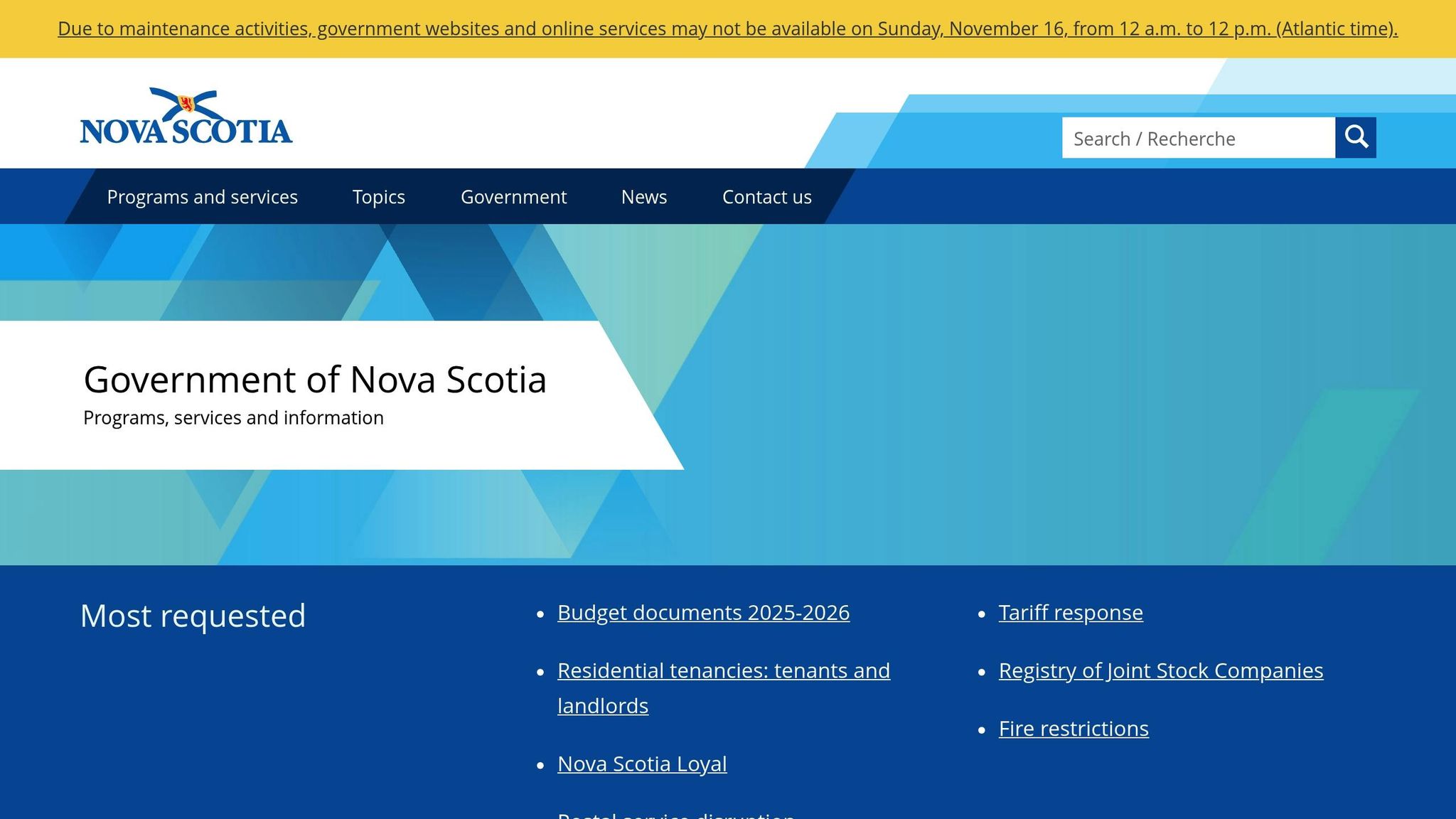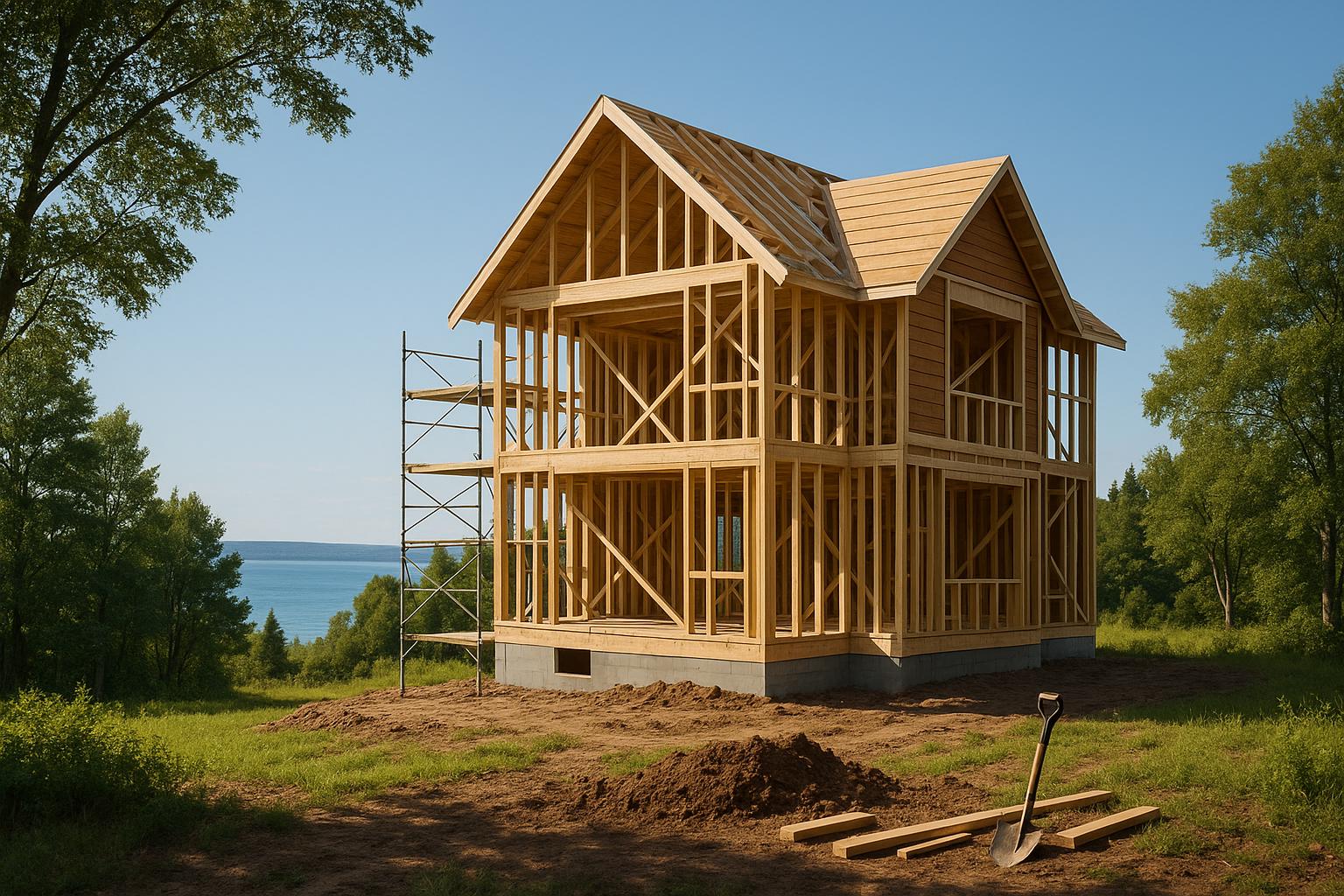When planning a property project in Nova Scotia, understanding subdivision (splitting land into multiple parcels) and consolidation (merging parcels into one) is crucial. These processes impact legal compliance, financing, and the development timeline. Here's what you need to know:
- Subdivision: Required when dividing land into separate lots, especially for multi-unit developments or adjusting property boundaries. Approval is mandatory for lots under 25 acres and involves two stages: tentative (preliminary) and final (legal creation of lots).
- Consolidation: Useful for combining smaller parcels into a single lot suitable for larger projects. It simplifies property management and financing.
Both processes require approval under Nova Scotia's Municipal Government Act, ensuring zoning, servicing, and boundary compliance. Working with licensed surveyors, planning consultants, and real estate lawyers can help avoid delays and legal issues. Choose subdivision for flexibility in ownership and consolidation for streamlined development. Always align these steps with your broader project goals for smooth execution.
What Is A Subdivision Plat On A Map? - CountyOffice.org

When Do You Need a Plan of Subdivision?
Understanding when subdivision approval is required can save both time and money, especially when dealing with multi-unit projects. While Nova Scotia has clear regulations, certain scenarios can still catch property owners by surprise.
Common Scenarios Requiring Subdivision
Subdivision approval is necessary in several situations, even beyond the basics of splitting or merging land. Here are some common examples:
- Dividing parcels for development: If you’re splitting a large property into smaller lots to construct separate rental buildings or homes, you’ll need approval. This process creates individual parcels that can be developed, financed, or sold independently.
- Adjusting property boundaries: Moving property lines to optimize layout or meet zoning regulations, such as frontage or setback requirements, requires approval. This might involve shifting boundaries between existing lots to better suit building plans.
- Combining non-contiguous parcels: Even when lots aren’t directly adjacent, merging them into a single development parcel still requires approval. This can help streamline land use rights for your project.
- Environmental factors: Properties with wetlands, steep slopes, or other constraints often need boundary adjustments to ensure compliance with provincial environmental rules. This ensures developable areas meet regulatory standards.
Legal Requirements in Nova Scotia

Nova Scotia's Provincial Subdivision Regulations outline the minimum standards for subdivisions, but requirements can vary depending on the municipality.
- Lot frontage: Most lots must have at least 15 metres of frontage on a public road, though Halifax Regional Municipality (HRM) has different rules for urban and rural areas.
- Surveying requirements: A licensed Nova Scotia Land Surveyor must prepare your subdivision plan. This ensures accurate boundaries, technical drawings, and compliance with provincial standards, helping to prevent disputes and errors.
- Approval authorities: Subdivision approvals are handled differently depending on where you are. HRM manages its own process, while smaller municipalities may rely on provincial staff. Applications are reviewed for zoning compliance, servicing needs, and development standards.
- Servicing considerations: Adequate access to water, sewer, and roads is essential. In areas without municipal services, you’ll need to prove that private systems - like wells or septic tanks - can handle the development. This often involves soil tests, well capacity assessments, or septic designs.
- Financing through CMHC: If you’re planning to use Canada Mortgage and Housing Corporation (CMHC) financing for your project, additional requirements apply. These include specific criteria for lot sizes, servicing, and development standards.
Once you’ve met the legal requirements, it’s important to understand the stages of the subdivision process.
Tentative vs Final Plans
The subdivision process typically involves two stages: tentative and final plans. Each stage serves a specific purpose and comes with its own timeline and requirements.
- Tentative plans: These are preliminary approvals for your subdivision concept. They let you test the feasibility of your project before committing to detailed engineering and surveys. Tentative approval usually lasts for three years, giving you time to secure financing and refine your plans. However, this approval is conditional - you may need to install services, conduct environmental studies, or make design changes before moving forward.
- Final plans: Once all conditions from the tentative stage are met, the final plan is prepared. This includes completing any required infrastructure and technical studies. Final approval legally creates the new lots, allowing you to transfer ownership or secure separate financing.
- Timelines: Tentative approval takes about 60–90 days, while final approval requires an additional 30–60 days. However, fulfilling the conditions for final approval can take anywhere from six months to two years, depending on the complexity of the project.
The distinction between these stages is critical for planning. Tentative approval provides development rights but doesn’t allow for the sale of individual lots or separate financing. Final approval, on the other hand, establishes the legal framework needed for these activities, making it a key milestone for phased construction or financing plans.
How Subdivision and Consolidation Work
Subdivision and consolidation in Nova Scotia involve a series of steps, clearly defined by provincial regulations. These steps ensure the process is methodical and compliant with legal requirements.
Application and Approval Steps
To get started, you must submit the "Application for Subdivision Approval" as outlined in Schedule "A" [1][4][5][6]. This document serves as the first step, providing key project details and formally initiating the review process.
Next, submit four copies of a preliminary plan. This plan should outline the proposed lots, features, and infrastructure. At this stage, a licensed surveyor is not required [2][3][4].
For the tentative stage, you’ll need to provide eight copies of a detailed plan. This plan must be prepared by a licensed surveyor and include a boundary survey of the subdivided area, though remainder lots are excluded from this requirement [2][1][4].
Finally, submit twelve original copies of the final plan, prepared by a licensed surveyor. This final plan defines your property boundaries in a legally binding manner [1].
sbb-itb-16b8a48
Subdivision vs Consolidation: Main Differences
Building on earlier definitions, let’s explore how subdivision and consolidation uniquely impact project planning. Your choice between the two shapes not only the scope of your project but also your financing options.
Process Comparison Table
| Aspect | Subdivision | Consolidation |
|---|---|---|
| Purpose | Splits one property into multiple parcels | Combines multiple properties into a single parcel |
| Documentation | Requires detailed plans and multiple submissions | Typically involves fewer documents, depending on municipal rules |
| Surveyor Involvement | Needs a licensed surveyor to create and review new boundaries | Involves a surveyor to verify and adjust existing boundaries |
| Review Process | Undergoes a thorough municipal review due to zoning and infrastructure requirements | Generally simpler, with less intensive scrutiny |
| Timeline & Cost | Longer process with higher fees due to detailed reviews | Quicker and often less expensive |
| Municipal Involvement | Extensive focus on zoning, lot sizes, setbacks, and services | Primarily ensures title and boundary compliance |
This table highlights how the procedural differences can affect your project’s timeline, costs, and complexity.
Impact on Project Planning
When it comes to subdivision, the process can add complexity and extend timelines. Each new parcel must meet zoning requirements, including frontage, setbacks, and access to municipal services. Additional upgrades or reviews may also be necessary to ensure compliance. While subdivision can increase tax assessments by treating each parcel individually, it also offers flexibility for financing and resale.
On the other hand, consolidation simplifies site planning by creating a single, unified property. This can streamline design and construction, and lenders often prefer evaluating a single, larger asset, which may make financing more straightforward. The approval process for consolidation is generally quicker, though challenges like title or easement issues may still arise.
Subdivision is ideal if ownership flexibility is your priority, despite its complexity. Consolidation, however, is better suited for projects that benefit from simplified planning and financing. Choosing the right approach is key to achieving your project goals efficiently.
Tips for Nova Scotia Property Owners
Navigating the processes of subdivision and consolidation can be tricky, but with the right planning and a strong team of professionals, you can avoid common setbacks and keep your project on track. Here’s how to approach these tasks effectively.
Working with Professionals
Start by building a local team of experienced professionals who understand Nova Scotia's unique development landscape. A local surveyor familiar with multi-unit developments in the province is essential. They’ll handle the boundary surveys and ensure plans meet both provincial standards and local bylaws.
Next, bring on a planning consultant who knows the ins and outs of your municipality’s development policies. Rules for lot sizes, setbacks, and infrastructure can vary widely - even within the Halifax area. A skilled planner can identify potential roadblocks early, saving you time and simplifying the application process.
Lastly, consult a real estate lawyer with expertise in subdivision law. They can review title searches, flag easements or restrictive covenants, and make sure all legal requirements are addressed. This step is crucial to avoid unexpected legal issues that could derail your project.
By assembling the right team, you’ll be better equipped to navigate the varying requirements across Nova Scotia’s municipalities.
Local Municipal Differences
Municipal rules in Nova Scotia differ significantly, even within a short distance of Halifax. For example, the Halifax Regional Municipality often requires detailed engineering studies for subdivisions involving four or more units. Larger municipalities may offer pre-application consultations to help streamline the process, but approvals for complex projects can still take time.
In smaller or rural municipalities, the requirements may be less demanding, but limited planning resources can lead to delays during peak periods. Additional assessments for infrastructure - like water, sewer, and road access - might also be necessary. Development charges and fees can vary depending on the location and complexity of your project, so it’s wise to budget accordingly.
A well-coordinated team can help you navigate these differences, avoiding unnecessary delays and expenses.
Avoiding Delays and Cost Overruns
Taking an integrated approach to your project can save you time and money. When surveyors, planners, architects, and builders work independently under separate contracts, miscommunication and scheduling conflicts can lead to costly delays.
Instead, consider uniting all experts under a single, coordinated team. This approach aligns subdivision planning, architectural design, and construction schedules, ensuring steady progress and avoiding the stop-and-start cycles that often plague traditional methods. Fixed-price construction models can also offer peace of mind by providing a clear cost breakdown upfront, covering both subdivision and construction expenses.
This streamlined strategy can make a big financial difference. By reducing coordination costs and avoiding extended delays, property owners can start generating rental income sooner, without the added stress of unexpected expenses.
Choosing a builder who views subdivision and consolidation as integral parts of the entire development process - not as separate hurdles - can be the key to a smooth and successful project.
Making the Right Choice for Your Project
Deciding between subdivision and consolidation is just the beginning; how you execute the process can make or break your project.
Subdivision is ideal when you need to divide larger parcels to create separate ownership opportunities or meet municipal requirements for multi-unit developments. On the other hand, consolidation is better suited for combining smaller lots to accommodate larger rental buildings or simplify property management. The choice should fit seamlessly into your broader development strategy rather than being treated as a standalone decision.
When these processes aren't aligned with your overall plan, it can lead to fragmented coordination and unnecessary costs. Disconnected contracts between surveyors, planners, architects, and builders often result in miscommunication, driving up costs by 30–60% and stretching project timelines from 8 months to over 18 months. This kind of inefficiency can derail even the most promising developments.
The solution? An integrated approach that ties subdivision planning directly to architectural design and construction schedules. Lloyd Liu, co-founder of Helio Urban Development, emphasizes the importance of this alignment:
"I personally guarantee every timeline because I've felt the pain of construction delays."
Liu’s insight stems from firsthand experience with the financial and logistical headaches caused by traditional construction methods. Delays are costly - imagine a fourplex that could generate $7,800 in monthly rental income sitting idle due to project holdups. An integrated team approach eliminates these setbacks, ensuring steady progress and timely income generation.
Opting for fixed-price construction models can also provide much-needed certainty. These models bundle subdivision and construction costs, offering clear expectations upfront. This not only aligns with municipal requirements but also streamlines compliance, allowing you to assess project feasibility without overcommitting resources.
The professionals you choose should treat subdivision and consolidation as strategic tools that advance your rental property goals. When properly integrated into your development plan, these processes can pave the way for a successful and profitable project, avoiding costly delays and maximizing returns.
Ultimately, your decision should align with your long-term objectives - whether that’s maximizing rental income, simplifying management, or preparing for future expansion.
FAQs
What’s the difference between a tentative and final subdivision plan in Nova Scotia?
A tentative subdivision plan outlines the details of a proposed subdivision, including the layout of any planned private or public roads. Many municipalities require this step before granting development approvals.
A final subdivision plan, on the other hand, is a legally binding document that finalizes the subdivision process. Once approved, it is registered with the local Land Registration Office, officially recording the updated property boundaries and layout.
What steps should property owners take to meet municipal requirements for subdivision or consolidation projects?
To make sure your project follows municipal regulations, begin by examining the local subdivision by-law and the Municipal Government Act. These documents detail the rules for dividing or merging land. Additionally, review your county's general plan and local zoning regulations to ensure your project fits within approved land uses.
It’s a good idea to work with a professional, like a surveyor or planner, who can guide you through these requirements and help you sidestep potential delays. Remember, meeting these rules can affect both your timeline and budget, so careful planning from the start will save you headaches later.
What financial advantages could consolidation offer over subdivision for property development projects?
Consolidating land parcels can offer several financial perks for property development projects, particularly in Nova Scotia. Combining multiple parcels into one can help cut down on administrative expenses, such as filing fees and legal costs, which are often higher when preparing separate subdivision plans. On top of that, it simplifies property taxes - one tax bill instead of several - potentially leading to long-term savings.
It also opens the door for larger-scale developments by creating a single, unified parcel. This can make the approval process with municipal authorities more straightforward, enhancing overall project efficiency. For developments like multi-unit rental properties, this could mean shorter timelines and better control over costs.



